Quarter-end turbulence
By Colin Twiggs
September 23rd, 2014 6:00 am EDT (8:00 pm AEST)
Advice herein is provided for the general information of readers and does not have regard to any particular person's investment objectives, financial situation or needs. Accordingly, no reader should act on the basis of any information contained herein without first having consulted a suitably qualified financial advisor.
Research & Investment: Performance update
ASX200 Prime Momentum strategy returned +22.64%* for the 12 months ended 31st August 2014 compared to +14.41% for the benchmark ASX200 Accumulation Index.
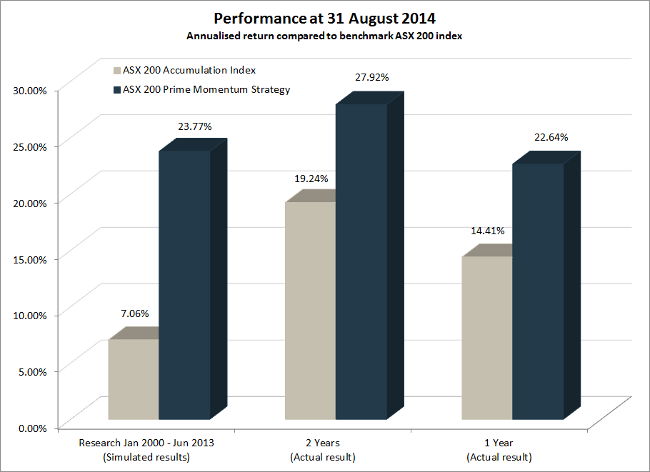
The S&P 500 Prime Momentum strategy had a good month, gaining 5.98% in August. The strategy has been running live for ten months, since November 2013, and returned 15.46%* for the period, compared to 15.96% for the S&P 500 Total Return Index. A sell-off of momentum stocks affected performance since April, but macroeconomic and volatility filters indicate low risk typical of a bull market and we maintain full exposure to equities.
* Results are unaudited and subject to revision.
Quarter-end turbulence
We are now approaching the September quarter-end, normally a volatile time for stocks. Investment managers tend to re-balance their portfolios after month-end, selling off poor performers and increasing cash balances to later take advantage of new opportunities. The result is that stocks tend to dip in October. If the fundamental under-pinning of the market is strong, they soon recover and continue on its merry way. But if there are serious flaws, the sell-off can turn into a rout — as in 1987 and 2007.
At present the market outlook appears sound and the bull market is likely to continue. I often use transport stock Fedex as a bellwether for the US economy. If the economy is robust, you can expect Fedex to display a solid up-trend. If weak, Fedex tends to lead the market lower. In November 2007 for example, on the monthly chart below, Fedex signaled a bear market several months ahead of the major indices. The present situation is quite the opposite, with the Fedex in a strong bull-trend, having recently respected support at $145. A 13-week Twiggs Money Flow trough above zero also suggests buying pressure. Economic activity is clearly improving.
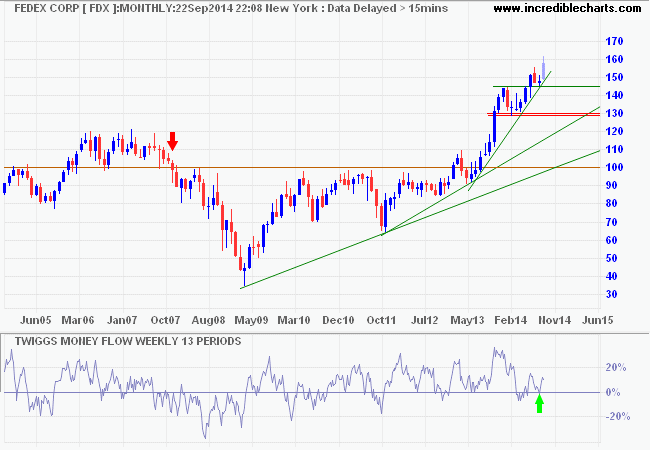
* Target calculation: 145 + ( 145 - 130 ) = 160
The S&P 500 break above 2010 proved to be a false break, with the market headed for a re-test of support at 1980. Breach would indicate another correction. Declining 21-day Twiggs Money Flow now indicates medium-term selling pressure; a fall below zero would warn of a primary down-trend.
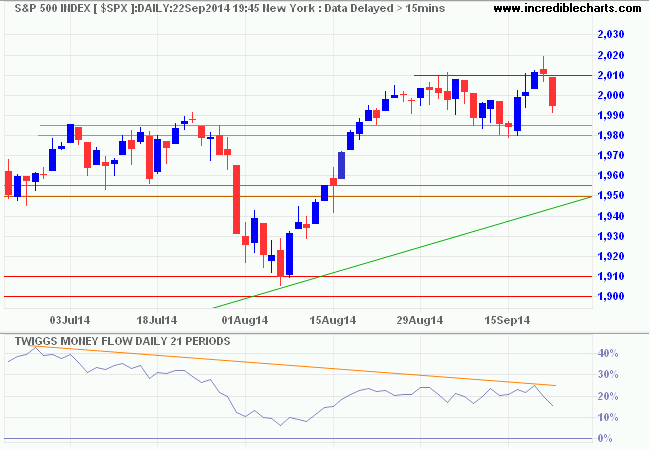
* Target calculation: 2000 + ( 2000 - 1900 ) = 2100
CBOE Volatility Index (VIX) remains low, however, suggesting continuation of the bull market.
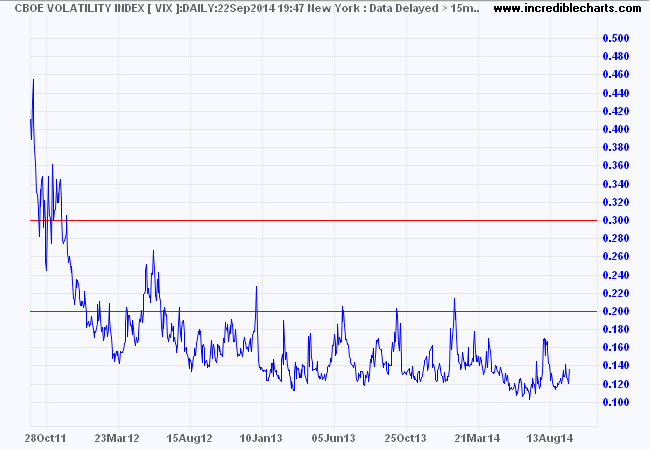
Dow Jones Industrial Average also retreated, testing its new support level at 17150. Reversal below 16950 would indicate a correction, while respect would suggest another advance. Declining 21-day Twiggs Money Flow also suggests medium-term selling pressure.
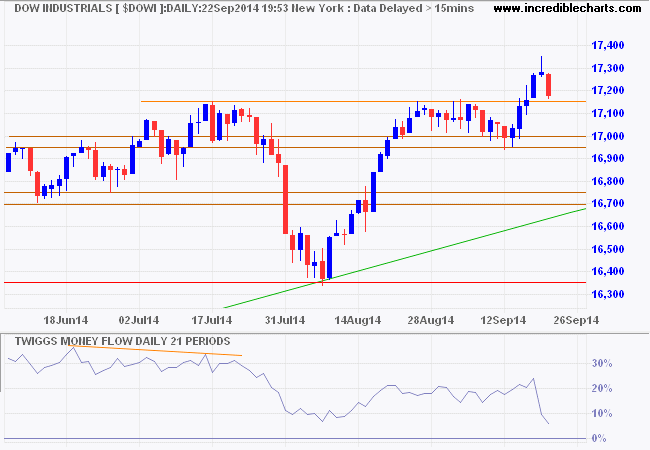
* Target calculation: 16500 + ( 16500 - 15500 ) = 17500
My conclusion is that the bull market is sound, but likely to encounter some turbulence over the quarter-end. There may be a secondary correction, but respect of recent support levels would indicate a fresh advance.
For my part, I favour an approach to statecraft that embraces principles, as long as it is not stifled by them; and I prefer such principles to be accompanied by steel along with good intentions.
~ Margaret Thatcher, Statecraft: Strategies for a Changing World (2002)
Disclaimer
Research & Investment Pty Ltd is a Corporate Authorized Representative (AR Number 384 397) of Andika Pty Ltd which holds an Australian Financial Services Licence (AFSL 297069).
The information on this web site and in the newsletters is general in nature and does not consider your personal circumstances. Please contact your professional financial adviser for advice tailored to your needs.
Research & Investment Pty Ltd ("R&I") has made every effort to ensure the reliability of the views and recommendations expressed in the reports published on its websites and newsletters. Our research is based upon information known to us or which was obtained from sources which we believe to be reliable and accurate.
No guarantee as to the capital value of investments, nor future returns are made by R&I. Neither R&I nor its employees make any representation, warranty or guarantee that the information provided is complete, accurate, current or reliable.
You are under no obligation to use these services and should always compare financial services/products to find one which best meets your personal objectives, financial situation or needs.
To the extent permitted by law, R&I and its employees, agents and authorised representatives exclude all liability for any loss or damage (including indirect, special or consequential loss or damage) arising from the use of, or reliance on, any information. If the law prohibits the exclusion of such liability, such liability shall be limited, to the extent permitted by law, to the resupply of the said information or the cost of the said resupply.
Important Warning About Simulated Results
Research & Investment (R&I) specialise in developing, testing and researching investment strategies and systems. Within the R&I web site and newsletters, you will find information about investment strategies and their performance. It is important that you understand that results from R&I research are simulated and not actual results.
No representation is made that any investor will or is likely to achieve profits or losses similar to those shown.
Simulated performance results are generally prepared with the benefit of hindsight and do not involve financial risk. No modeling can completely account for the impact of financial risk in actual investment. Account size, brokerage and slippage may also diverge from simulated results. Numerous other factors related to the markets in general or to the implementation of any specific investment system cannot be fully accounted for in the preparation of simulated performance results and may adversely affect actual investment results.
To the extent permitted by law, R&I and its employees, agents and authorised representatives exclude all liability for any loss or damage (including indirect, special or consequential loss or damage) arising from the use of, or reliance on, any information offered by R&I whether or not caused by any negligent act or omission.

Author: Colin Twiggs is a former investment banker with almost 40 years of experience in financial markets. He co-founded Incredible Charts and writes the popular Trading Diary and Patient Investor newsletters.
Using a top-down approach, Colin identifies key macro trends in the global economy before evaluating selected opportunities using a combination of fundamental and technical analysis.
Focusing on interest rates and financial market liquidity as primary drivers of the economic cycle, he warned of the 2008/2009 and 2020 bear markets well ahead of actual events.
He founded PVT Capital (AFSL No. 546090) in May 2023, which offers investment strategy and advice to wholesale clients.
